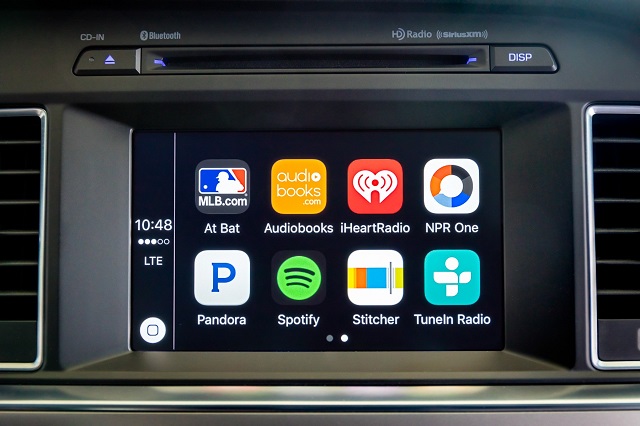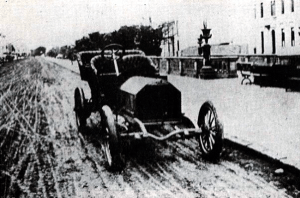Whether it’s a dreary, morning commute or a wind-in-your-hair sunset cruise, a car ride just isn’t the same in silence. It’s this universal appetite for good listening where car radio history begins.
Vehicle audio has been around in one form or another for nearly as long as there have been automobiles on the road. Initially, car owners would take portable battery radios on their journey. It wouldn’t take long for a superior option to arrive on the scene thanks to a now-famous company that was just trying to stay afloat during its nascent stage.
1930: The First Car Radio
In 1928, brothers Paul and Joseph Galvin founded the Galvin Manufacturing Corporation. The company produced battery eliminators, devices that enabled battery-powered radios to operate on household electric current. As more radios began running through home electrical systems, however, battery eliminators became obsolete.
Coupled with the financial effects of the Great Depression, the Galvins needed a new product to stay in business.
The brothers recruited a group of engineers to build a radio that could be installed in automobiles. Putting various parts inside the car and others underneath the floor, the crew successfully manufactured a sturdy radio that received a clear signal and could withstand rough roads.
Paul Galvin unveiled the device in grand fashion, driving from Chicago to Atlantic City to demonstrate the radio at the 1930 Radio Manufacturers Association Convention. Unregistered for the event and without a booth, Galvin parked the car outside and turned up the radio’s volume. The stunt drew hordes of spectators and by the time he left Atlantic City, Galvin had secured enough sales to keep his company in business.
But what would they call this new technology? Wanting a unique name for its product, the Galvin Corporation combined “motor” from motorcar with “ola” from Victrola (a popular line of phonographs) to create Motorola. The moniker quickly became so well-known, the company changed its name to Motorola, Inc.
1953: The Groundbreaking Becker Mexico
Technological advancements over the following two decades spurred improvements to the size and functionality of car radios. In 1953, the Becker company reached a major milestone in car-radio history when it unveiled its now-legendary Mexico model. Arguably the first high-end car radio, the Becker Mexico featured FM stereo and was the first in-car radio with a fully automatic station scan.
1955: Chrysler’s In-Car Record Player
Through the mid-1950s, drivers were at the mercy of radio stations when it came to musical choices. That began to change when Chrysler unveiled a car record player known as the Highway Hi-Fi. It was developed by Peter Goldmark, head of CBS Laboratories, who had previously invented the 33 1/3 Long-Playing (LP) record. The system was mounted underneath the dashboard and would project forward with the push of a button.

Because 12-inch, 33⅓-rpm records were too big, and smaller, 45-rpm records played just one song, Goldmark needed a new format. He developed a record with groove spacing one-third the width of an LP. Combined with a slower turntable, this allowed these new records to be just 7-inches wide, yet play the same amount of music as a 12-inch LP.
Goldmark tested the system in his own Chrysler with great results. His bosses were less than enthused with the ingenuity, however, believing in-car record players would steer listeners away from CBS-owned radio stations.
Undeterred, Goldmark went straight to the car manufacturer. He successfully sold the idea to Chrysler, which offered the Highway Hi-Fi as an add-on to several of its 1956 models. While noble in its intention, the record player ultimately proved more problematic than its worth.
It came with six propriety records, none of which were major hits. They included the soundtrack to “The Pajama Game” musical, Tchaikovsky’s “Symphony in B Minor” and songs from Walt Disney’s “Davy Crockett.” If customers wanted more options, they had to purchase new records. Even then, they could only choose from a small subset of Columbia Records’ catalog. (Columbia was the only company producing the 7-inch records.)
The biggest issue with the Highway Hi-Fi, however, was its functionality. Goldmark had gone to great lengths to ensure records wouldn’t skip as the car drove, performing numerous tests on premium Chrysler models. But the carmaker also offered the record player on lower-end Dodges and Plymouths, which had inferior suspension systems. This caused the records to skip and the warranty claims to mount. Combined with the device’s high price (more than $2,000 today), these drawbacks ultimately doomed the Highway Hi-Fi. It was discontinued just a few years later.
1960s-70s: Eight Tracks and Cassettes
The in-car record player was down but not out. In 1960, Chrysler replaced the Highway Hi-Fi with the RCA Victrola turntable. The device held a total of 14 singles that would play one after another. The UK’s Auto Mignon was a more compact record player, though it only held one 45-rpm record at a time.
Before the in-car record player could be perfected, Ford and Motorola jointly introduced the eight-track tape player in 1965. It remained the go-to choice for car audio throughout much of the 1970s.
Cassette tapes, which were initially developed in 1963, began supplanting eight-track players in the late 1970s as tape quality improved. They would remain extremely popular, both in and out of cars, through the 1980s.
1984: Compact Discs
Compact disc players made their way into cars in the 1980s. The first was the Pioneer CDX-1, introduced in 1984. Lincoln offered the earliest factory-installed player in its 1987 Town Car model.
This new technology offered a far-better listening experience than any previous option. CDs had vastly superior sound quality and were more durable than cassettes. Plus, listeners could instantly skip tracks with the push of a button instead of rewinding or fast-forwarding. Car CD players became ubiquitous by the 1990s.

2000s: The Brave New World of Car Radios
Many new chapters have already been written in car-radio history this century. Through the use of USB, auxiliary cords and Bluetooth, drivers started connecting their mobile devices to car radios beginning in the early 2000s. Nowadays, most cars allow drivers to sync their phones to the car radio via Apple CarPlay and Android Auto. These apps give users hands-free access to their music, as well as streaming services like Pandora and Spotify.
The 2000s also introduced the world to satellite radio. As opposed to terrestrial radio, which has a limited signal range, satellite radio can broadcast over an entire continent with crystal-clear clarity. This feature has made it a popular option for car listening.
What’s your favorite car radio memory? Where will car audio tech go next? Let us know in the comments below!
If car radio history has whet your appetite, head to our auto history section for more stories on automotive evolution.
26 Thoughts on “A Timeline of Car Radio History”
Leave A Comment
Comments are subject to moderation and may or may not be published at the editor’s discretion. Only comments that are relevant to the article and add value to the Your AAA community will be considered. Comments may be edited for clarity and length.


















I was a licensed ham radio operator at the age of 13 so I understood vacuum tube electronics. I enjoyed explaining to people what the humming noise was they heard when they first turned on a car radio in the seconds before it began to play. The humming noise was the “vibrator” in the power supply section of the radio. Because the radio used vacuum tubes before semi-conductors (transistors) were perfected, the radios needed high-voltage alternating-current to operate. The vibrator changed direct current low voltage (approx 12-14 volts) from the car battery into alternating current low voltage which then could feed the primary windings of a step-up transformer (transformers only work on alternating current) where the secondary windings would provide sufficient plate and cathode heater voltage (100’s of volts) required by the detector, amplifier, and oscillator tubes in the receiver chassis. The delay receiving audio output upon starting was due to the cathode heaters in the vacuum tubes reaching operating temperatures to allow anode, cathode, and bias grids to function properly inside the vacuum of the tube. Try to learn something everyday.
My car during college in the early 1970’s was a VW Beetle. After graduation, my top priory was a new car. I test drove a 1974 Old Cutlass Supreme and during the test drive The Doobie Brothers “Black Water” was playing on the greatest sounding car stereo I had ever heard. Yep – I bought the car pretty much entirely based on how sweet the radio sounded. Drove that car for around 8 years and never once regretted the purchase!!!